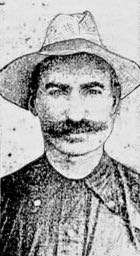The Days of Martini’s Buckjumping Show
© Chris Woodland
Dargan’s Grey – Queensland again
A little over three months after the Lithgow performance the Queensland newspapers reported that Martini Brothers and their buckjumpers were said to be performing at the National Association’s Show in Brisbane in August. Here again we see that Martini is performing with a possible brother.
The month prior to the National Association’s Show in Brisbane Martini’s Band of Rough Riders pitched their tent adjacent to the Criterion Hotel near the Court House in Ipswich. They performed on Friday 19 July 1902 and to everyone’s surprise the main attraction displayed a very disappointing exhibition of bucking. Dargan’s Grey was ridden by a Thomas O’Brien and was not thrown. Some members of the audience complained that the rider had held onto the pommel of the saddle. O’Brien also wore spurs, which could have compromised the usual violent behaviour of the Grey.
In late August, Following the National Association’s Show, Dargan’s Grey was back to normal at the Woolloongabba Cricket Ground and throws the two contestants who attempted to ride him. These buckjumping events of Martini’s were now widely covered in the country’s press and this show at the Woolloongabba Cricket Ground received a special mention in the NSW paper the Hawkesbury Herald, the area having a long association with the famous Grey. The paper claimed that:
… the grey demon was to be ridden in the electric light, at the Gabba and that: One of the only men who rode Dargin was the late lieutenant Morant (The Breaker). This was at the Hawkesbury Show. Dargin had already unseated 16 would-be conquerors and was knocked up when Morant rode him.
This feat of the Breaker’s was to become well know over the next few years, though the number of riders preceding him on that occasion was not usually mentioned. Having thrown 16 men in succession would leave the grey wonder horse little hope of throwing a horseman of Morant’s ability.(( Morant had been executed by the British in South Africa earlier in the year on 27 February. )) The mention of the electric light shows that this new invention was slowly snaking its way across the country and was obviously advertised as a great benefit to evening performances of all kinds.
In the third week of October 1902 Martin’s Rough Riders performed at Maryborough where the proprietor:
… on the horizontal bar gave an exceedingly clever performance, which was alone worth the price of admittance. Also, Dargan was very fit … The marvellous performance of Dargan’s grey [sic] will not soon be forgotten by those who witnessed it.
Records of Martini’s Buckjumping Show are difficult to find over the next few months, but they had been slowly moving northwards performing at places along the way, finally passing through the large gates into Parramatta Park at the Cairns showgrounds. Throughout their travels Martini’s Buckjumpers would perform for one evening, or more as they passed through towns and small settlements, should the patronage be there, providing there was no deadline for approaching commitments.
They had arrived for Cairns’ annual show festivities and here they were joined by a small family group of show people consisting of Harry and Ada Seymour and their children. The Seymours had a great passion to eventually own a large circus, but after many miles and colourful and demanding experiences it was not to be. (( Fred Lord in his book Little Big Top tells of the Seymour’s journey and exploits as told by Ada. ))
Martini asked the Seymours to join their group at the Cairns show, which they did. Apparently they retained their individuality while performing with Martini’s Buckjumping Show and were to stay with the group for many miles to the top of Queensland and back again to Cairns. Ada said that Mart, as she called Martini, was doing very well and making good money and could pay well. Like most others, the Seymours spoke highly of Martini.
It was now mid 1903. Between 700 and 800 people attended the opening at Cairns of Martini’s show which received an astonishing reception. The Morning Post claimed that Martini’s performance on the bars:
gave an exceedingly clever performance which was alone worth the price of admission.’
The only other familiar name mentioned is that of Miss Mena Val who gave a clever slack wire walking act and a trick cycling performance. It appears some Aboriginal roughriders turned up to try and master Martini’s buckjumpers. A native tracker, coincidently named Seymour, was unsuccessful in his first endeavour, but succeeded in riding a Mr Black’s horse and was awarded 10 shillings by Martini for his performances. Another Indigenous ringer by the name of Jasper had difficulty in attempting to get on an outlaw and created much amusement for the audience. Dargan’s Grey gave an unforgettable performance and showed the conscientious Seymour who was the master.
Unless one witnessed the old grey buck, it would hardly be
believed that any horse could tie himself in so many knots
in so short a time.

